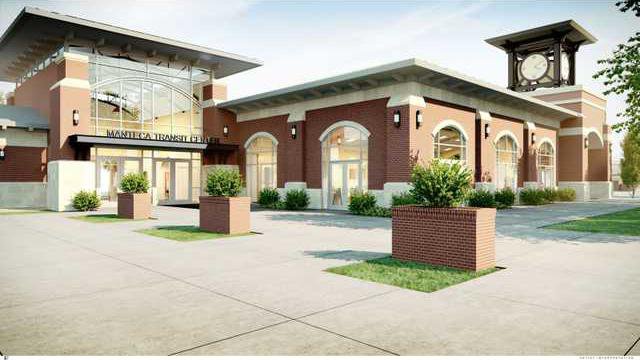Stockton spent 2012 watching as Wells Fargo Bank repossessed their future 8-story city hall and three downtown parking structures.
Meanwhile Manteca forged ahead with four municipal buildings valued at $18.1 million. That’s in addition to investing over $14 million in municipal funds into the renovation of a family homeless shelter and helping fund a 152-unit workforce apartment complex.
“The year 2012 was a time for the City of Manteca to build,” Manteca Mayor Willie Weatherford said.
And build the city did.
• The $7.3 million transit center that will do double duty as a community center and gathering place of sorts is underway at Moffat Boulevard and South Main Street. The modern brick building with expansive glass accented with arches inside and out will come complete with a clock tower visible to both South Main and Moffat traffic.
• The $2.1 million state-of-the-art animal shelter at Moffat Boulevard and Wetmore Street is wrapping up its first full year of operation.
• The Hope Family Shelter at Yosemite and Sequoia avenues was modernized, upgraded and designed to mirror the look when the building was new in 1919. The project used $1. 2 million in Manteca Redevelopment Agency funds.
• The new $4.7 million city vehicle maintenance facility was completed at South Main and Wetmore Street replacing an aging and dilapidated building that is almost 90 years old.
• The 152-unit Juniper Apartments were completed on Atherton Drive. The $29 million project was built with the help of $13 million in Manteca RDA funds. The complex is designed to provide workforce housing. It is the first project of its kind in Manteca.
• A new $3.5 million fire station - the city’s fourth - broke ground in November on Lathrop Road at Madison Grove. It is designed to blend in with the adjoining Del Webb at Woodbridge neighborhood. It will bring more than 3,000 homes in northwest Manteca into the targeted five-minute response time for emergencies.
Weatherford noted the city had saved up the money collected from growth fees to have most or all of the funds on hand before starting construction of the various projects. As a result, Manteca has been able to take advantage of lower construction costs to get more bang for the buck.
The mayor said he’s looking forward to the transit center being completed next spring. And while the extension of Altamont Commute Express passenger service to Modesto is still a ways off meaning trains won’t be stopping at the station until some time in the future, much of the complex was designed as a community meeting facility. It is something that Weatherford believes will be used by a lot of groups as well as for events and weddings.
The transit station will be completely paid for when work is finished.
What transit station includes
The transit station includes:
• a large community room that can be divided in two for use for dinners, receptions, and other events complete with a kitchen facility.
• an expansive outdoor plaza designed to accommodate events such as an outdoors farmers market.
• a large clock tower visible in all directions.
Architect Eric Wohle of LDA Partners has described the station’s design with its extensive use of brick, varied elevations of cast stone, window arches, and a steel canopy entrance for the plaza as embracing a “Grand Central” theme. The design is carried on inside throughout the lobby and the community rooms with a high ceiling complete with arch trusses in the lobby to provide the building with the appearance of looking taller than it really is.
The design is about more than just pleasing the eye.
• The higher pitched ceiling in the community room has been designed with dropped “clouds” consisting of acoustical panels to soften noise.
• The materials used - such as wainscoting on the walls in the lobby and the community room - are designed to reduce maintenance costs.
• The design has been modified so if one person is on staff in the building at the ticket window that they have a clear visual line to the community room entrances.
The restrooms accessible to the public and the community room address a common complaint women have - not enough toilets. The women’s bathroom has eight toilets while the men’s side has two toilets and a pair of urinals.
There are 108 parking spaces on the 3.1-acre site, bus drop off zones with shelters and safety fence to keep passengers away from Moffat traffic. A vehicle drop-off zone would be in place on Moffat as well as on site complete with a turn-around. Dedicated left turns would be added to Moffat for entering the transit station parking lot. A pedestrian crosswalk would also be added on Moffat.
Funding for the project is from county, state, and federal sources that are restricted to transit related projects. It includes $2.6 million from the federal Transit Administration, $1.8 million from Proposition 1B, $1.5 million from the Regional Surface Transportation Program, $256,000 from the Local Transportation Fund, and $700,000 from Measure K countywide transit sales tax receipts.
No general fund money is being used to build the facility. In addition, state and federal pass through funds for transit use will be employed to maintain and operate the station.
Manteca building, not retreating
City spends $32.1 million on buildings, apartments





